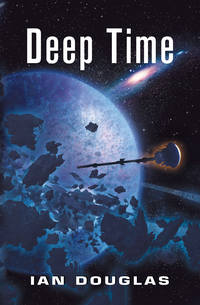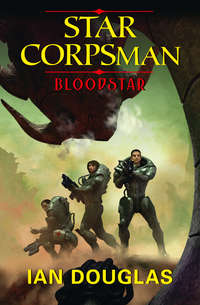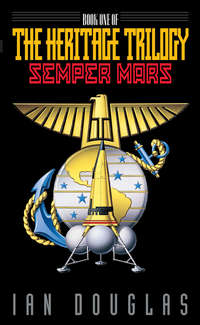
Полная версия
The Complete Heritage Trilogy: Semper Mars, Luna Marine, Europa Strike
“If I knew that, Monty, I’d be president.” He shrugged. “Hell, Markham’s pro-military, which is a point in our favor, and I have the feeling he’d grab at just about any chance, however slim, to get us out of this bind with our honor intact as well as our territory. But I also know that Matloff is right about the odds we’re facing. Our best hope, the country’s best hope, is for a settlement with the UN that gives them most of what they want…and lets us maintain our sovereignty a little bit longer.”
“Admiral, you can’t agree with that…man.” He stifled the urge to use a stronger word, and it nearly choked him.
“The trouble is, Matloff is right. Sooner or later, that one-world state we’ve been hearing so much about is going to happen, just to make sure food and resources get properly distributed all over the globe, if nothing else. When it does, the United States is going to lose an awful lot of its power, its prestige, and maybe its territory as well. If it comes down to a choice between giving up on what we’ve built on Mars, and having the UN occupy the US the way they did Brazil, well, I know what I would have to choose.”
“So…our people are on their own.” He thought of Ted, alone on the embassy rooftop as the transport lifted off without him. He felt sick.
Gray hesitated for a brief moment, then dropped his eyes. “Yes.”
“I’d like to work out a way of getting a message back to Garroway, sir. I know we can’t send e-mail back the same way we got it, not without risking tipping the bad guys off, but Garroway’s daughter may have a back door for us.”
“That’s a negative.”
“But—”
“I said negative. Harrel was specific on that point, and he made sure to tell me to pass it on to you, loud and clear. If the president needs negotiating room on this, he can’t have us undercutting his position by sending messages to Garroway.”
“What?”
“If the UN intercepts our messages to Garroway, they could claim that Markham was negotiating with one hand and managing some kind of guerrilla operation on Mars with the other. We can’t take that chance, Monty. We can’t even acknowledge that we got his message in the first place. The fact that we know the UN pulled an offensive move against us up there when they don’t know that we know what they did, well, that might provide us with some leverage in Geneva. As far as you and I and everybody else on Earth is concerned, we have no idea where Garroway is or what he is up to.”
“You’re abandoning him, then.” The words were hard and bitter.
“Call it plausible deniability. Anyway, it’s not as though we could do anything to help. The next cycler’s due for Earth return next week, but we don’t have time to put together a reinforcement mission. Even if we did, it’d be another eight months before they could reach him.”
“Just knowing that you’ve got people pulling for you can help sometimes, Admiral. Right now, I’d guess that Garroway and his people are about as lonely as any US military detachment has ever been in history.”
“Well, God help them,” Gray said. “Because we can’t.” He stopped and held Warhurst with his gaze. “I mean that, Monty. That’s a direct order. No communications with Garroway until this matter is resolved.”
“Aye, aye, sir.”
In thirty-six years of military service, Montgomery Warhurst had never disobeyed an order…but damn, he was tempted to now.
SIXTEEN
TUESDAY, 29 MAY: 0230 HOURS GMT
Tithonium Chasma, Mars
Sol 5637: 1330 hours MMT
It was, Garroway thought, one of the oddest-looking marches in the annals of military history…the Mars cat, a bug-faced, tracked monstrosity piled high with stores and armored Marines, grinding along at the pace of a man’s walk and dragging behind it in a swirling cloud of dust a flat sled similarly loaded down with men and supplies.
The sled was the brainchild of Gunnery Sergeant Knox and Staff Sergeant Ostrowsky, who’d suggested the idea as a way of beating some unpleasant facts of life. The Mars cat was designed to carry six to eight people comfortably, but experiment demonstrated that sixteen could be jammed in with considerable crowding, a crowding made worse by the fact that none of the people aboard would remove their armor during the trek. Six or eight more at a time could ride on top of the crawler, clinging to plastic straps rigged from cargo-handling grips.
That left at least four more who would have to walk…and anyone moving on foot would drastically slow the cat from its usual fifteen to thirty kilometers per hour down to the two to three kph that could be expected of a human in full armor trudging along through the sand. At one point, during the planning before they’d left Heinlein Station, Garroway had been convinced that he was going to have to leave at least four of the Marines behind, simply because they couldn’t afford to crawl all the way to Candor at the speed a man could walk.
His two senior NCOs had suggested an alternative, however. A number of carbaluminum pipes—sections for the microwave relay mast that was to have been built at Heinlein Station in the near future—were stored outside the hab. The interior walls of the hab were made of foamboard, a lightweight composite-material used extensively in the cyclers and other MST-derived habs and spacecraft for interior fittings. By wiring sheets of foamboard cut from the hab partitions to an X-framed rectangle of carbaluminum piping, a team of Marines had managed to jury-rig a sled four meters long and three wide and attach it to the Mars cat by its rear tow cable.
“Now, in the old Marine Corps,” Knox had wisecracked, “we could go weeks at a time without food. Just thinking about those old MREs was enough to keep us going on spit and cusswords. But a tow-sled’ll let us carry enough food and water to see us through a couple of weeks, anyway, and it means the people outside can ride instead of walk.” The sled would also carry some of their bulkier equipment—fuel-cell-powered heaters, a rolled-up plastic pressure tent, and spare tanks of liquid oxygen and nitrogen.
The whole assembly looked bizarrely improbable once it was loaded and yoked to the cat’s winch. It was a compromise and, like all such, was not perfect. The drag sled slowed the cat considerably. Both because of the strain put on the Mars cat’s electric drive and for safety reasons, the cat would not be able to make much better than eight kilometers per hour, at the very best…and in rough terrain, the Marines outside would have to actually carry the sled like a huge canoe, portaging their way across the steepest or roughest stretches.
Nor could they travel a full twenty-four and a half hours a day. The period of the Martian night between midnight and dawn was far too cold for Marines to remain outside for more than two or three hours at a time, nor could the cat’s engines take the sustained punishment of round-the-clock travel with that kind of load. They were going to have to stop and camp for at least six hours each night while the cat’s fuel-cells recharged, and the people riding outside would all have to be cycled through the cat’s interior every couple of hours in order to get warm and to recharge their suits’ batteries.
They’d made only fifteen kilometers that first day, traveling southeast to pick up the opening in the encircling chasma walls that would give entrance to an extremely narrow and steep-sided canyon. According to maps found aboard the Mars cat, this was where the wider portion of Tithonium was squeezed down to a slender rille—actually a chain of deep fault-collapse craters puncturing the surface in a straight line all the way to the broad expanses of Candor Chasma, some 450 kilometers to the east.
They’d not set off, however, until a scant two hours before sunset, and moving at a slow and painful crawl, they’d managed about ten kilometers before the sun set. The Martian night swept down the valley with astonishing swiftness, the sky fading from pink to orange to deepest, star-strewn black within the space of a couple of minutes. The outside temperature began plummeting as well, from minus five centigrade to minus forty-five in the first three hours after sunset.
With nightfall, they kept going…but their speed was reduced even further. Garroway didn’t want the cat to show lights, not with the very real possibility of a UN air search by lobber, and the two tiny moons shed almost no illumination on the dark desert floor. Marines took turns walking ahead of the Mars cat, scouting out obstacles like craters or boulders and slowly guiding the vehicle through the night practically step by step.
And they were still on the flat and sandy floor of the chasma; their progress would be slower still once they entered the rougher terrain of the canyon proper.
At some point around local midnight, Garroway had called a halt, set the watches, and let the party hunker down for a restless night. At the very best, at this rate of travel, Garroway estimated that they could make the passage from Heinlein Station to Mars Prime in four to five days…if they could average ninety miles per day—almost 150 kilometers—across almost four hundred miles.
He knew better than to expect that kind of average, however. Given the fact that they faced unpredictably rough terrain and the likelihood of things breaking down or simply taking longer than expected, he figured they would be lucky if they managed something on the order of ten to twelve days instead, and a much longer time was distinctly possible. Water was going to be a headache, with food and air nearly as bad. They were carrying as much extra water as could be held in a pair of large, pressurized drums, plus enough readymeal packets to last twenty-eight people for twenty days. The air re-circulators both in the cat’s cabin and in their suit PLSS backpacks would extend their breathing time, but they would need occasional recharges of liquid oxygen and nitrogen to make up for the unavoidable loss each time an airlock was opened or a helmet was removed. Garroway’s best back-of-the-envelope calculation said…twenty to twenty-five days, depending on their exertion. If they didn’t make it in that time…well, he could always call for help. That meant surrender, however, an option he was not willing to consider.
Not yet.
During the drive out from Heinlein Station, Garroway, King, and Knox had worked out a rotation schedule for the twelve people outside. Each night after they stopped, every person in the party would spend a two-hour security watch outside, the ones outside exchanging with the ones inside. It looked like no one was going to be getting much sleep on this trek, not with everyone taking a turn freezing in the desert each night.
Garroway had insisted that both he and King take their turns outside with the rest, and he volunteered for the first watch. Alexander had volunteered himself and the other two scientists too, but Garroway had turned him down. Marine Corps armor was designed to stand up to the horrors of the NBC battlefield and, with adequate power, could handle life support for literally days on end. The three scientists were wearing lightweight EVA suits with much weaker heaters and power units, and he didn’t want to risk losing the civilians in his charge.
The Marine armor should be able to take the cold, though he had plenty of reason to question that the first night, as he stomped around outside, trying to stay warm in the pitch-black of the frigid Martian night. Class-One armor was rated at sixty below for four hours, but as far as he knew, no one had tested it yet at lower temperatures. He would have his people stick with two-hour watches, at least for now.
Garroway had a lot of time to think, he found, walking around on the desert with the other outside Marines, trying to keep his feet warm as his suit’s heaters battled the frigid cold. No one spoke. They were officially on radio silence, though everyone had cables and jacks that would let them hard-wire into one another’s intercoms if they wanted to chat. There didn’t seem to be much to talk about, however.
When his watch had ended at last, he’d limped inside, found a place to wedge in between two other Marines, and fallen into an exhausted and fitful sleep. All too soon, King had used the suit intercom to wake him, alerting him to the fact that it was an estimated one hour before daybreak and time to get moving once again.
Soon they’d gotten under way, seeking to put as much distance between themselves and Heinlein Station as they could. Garroway was certain that the UN guards must have some sort of call-in routine, and that call-in was long overdue by now.
The first rays of a golden sunrise were just beginning to touch the floor of Tithonium Chasma as the Mars cat started to climb up a sandy ridge, snaking its way higher and higher up the eastern escarpment of the chasma. During the night, Kaminski had attached his flag to the cat’s whip antenna, and it made a brave sight as it fluttered in the thin wind above the vehicle’s cab. Progress was slow, however, and at times the Marines riding outside had to dismount and carry the sled over rough spots, while the Mars cat ground forward with painful deliberation along the steepening, narrowing path.
By 0900, Mars time, they’d crested a saddle between the two cliff walls. The path cut sharply left and on up to the top of the cliff, where it emerged on flat and open terrain. That, Garroway knew, was the regular crawler route; radar beacons had been set along the path to mark it, and he could see the tracks the cat had left when it’d come this way a few days before. Directly ahead, though, the terrain turned ominous, plunging into a broken and tortured landscape of cliffs, craters, and boulders. According to the maps on board, that was the continuation of the Tithonium Chasma, a narrow and rough-bottomed canyon that ran arrow straight toward Candor.
Garroway tapped the shoulder of the crawler driver—it was Sergeant Caswell this watch—and pointed ahead. She nodded inside her helmet and, without hesitation, gunned the vehicle’s electric motors with the foot pedal and sent them lurching forward.
Bergerac would expect them to take the fast and easy route to Mars Prime, the one over smooth terrain that would get them there in a day or two. By staying in the chaotic badlands of the canyon, Garroway was taking a fearful risk of breakdown or outright catastrophe if the cat slid off a cliff or got mired in soft sand. But the canyon also gave them their best chance of evading the patrols—both on land and in the air—that Bergerac was certain to employ. Marines always avoided the regular paths and trails when they could.
Garroway thought it worth the risk, especially since his comments to Kettering and Vandemeer about staying on the main track might well reach Bergerac’s ears.
He just hoped he’d guessed right, because they were less than a full sol into the march, and it was already beginning to take on some of the overtones of hell.
SATURDAY, 2 JUNE
International Space Station
344 kilometers over the North
Pacific Ocean
0915 hours GMT
It was called the International Space Station, and the fiction of global cooperation had been maintained over the years, despite the realities of world politics. The design once planned as Space Station Freedom, and later as the International Friendship Station, had eventually become Earth’s lone orbital spaceport, a spindly, Tinkertoy collection of struts, modules, solar panels, and trusses circling the globe in low Earth orbit.
When construction had begun during the last couple of years of the previous century, the facility had been planned with a twenty-year life expectancy. By 2041, the station was definitely showing its age; it had always been easiest and cheapest simply to add new components to one end of the aging structure, rather than starting fresh with something new. The original station main module, called the Alfa Complex—leaking now through a dozen badly deteriorated pressure seals and valves—was relegated to storage of non-vacuum-sensitive supplies, while the docking facility was located at the far end, eighty meters distant. To either side, four sets of solar panels stretched like vast and glisteningly black damselfly wings spread from the slim and segmented white body.
Despite its age, the ISS remained the premier human facility in orbit, and a true spaceport. When the joint US-UN Return to the Moon mission was launched in 2012, the landers had departed from the ISS. Mars One was assembled there in sections by NASA workers berthed in a temporary hab adjoining the station, and Columbus, the first cycler, was also assembled and launched from the ISS.
There were other stations in LEO as well, Japan and the ESA both had small, independent facilities in the same orbit, some fifty kilometers ahead of the ISS, while the United States maintained a half dozen free-flying stations either in LEO or in higher, polar orbits. The International Space Station, however, was by far the largest, eighty meters long, with solar panels spanning over two hundred meters, with a permanent crew of fifteen to twenty people, and room for as many as fifteen short-term visitors.
In keeping with its designation as a spaceport, its facilities included twelve Shuttle II fuel tanks now filled with water and cryogenic oxygen and hydrogen, fuel for the cyclers, the UN moonships, and the small fleet of tugs that serviced the other space stations in the vicinity and even made weekly treks out to the L-5 facilities. Most of the other LEO stations, in fact, were positioned within a few tens of kilometers of the spaceport, partly for convenience, partly for safety. The fleet of Mark IV space tugs stationed at the ISS were valuable both for routine repair and maintenance of all the orbital structures and for evacuations, if such became necessary.
What no one seemed to have considered so far, though, was what would happen if something went wrong with the ISS.
Colonel Paul Gresham was not particularly worried about structure failure at the moment…though the ISS carried an uncomfortably long list of things on its maintenance log that needed to be checked, replaced, or repaired. He was concerned, however, about the human components under his command. The political situation was getting damned dicey.
Gresham carried the rank of colonel in the US Aerospace Force, but he was currently assigned to NASA, had been, in fact, ever since he’d been accepted for the astronaut program eight years before. He was the commander of the ISS, a position that, by international agreement, was rotated among the senior members of the current station staff on a monthly basis. It was a cumbersome system, and one that never worked entirely to perfection. Last month, the CO had been LeClerc, with the ESA contingent. Next month, the position was due to rotate to Zhang Shu, of Manchuria…unless the scuttlebutt he’d heard was accurate and Zhang got recalled early. If that happened, chances were that his Russian counterpart, Kulagin, would get the job.
It was annoying having necessary work, tight schedules, convenience, and even safety all twisted out of shape by politics, but that seemed to be the price for running a truly international space station in the uncertain political situation of the day. The irony was that most of the people on ISS duty couldn’t care less about politics. There was something about being able to float over to a nearby port and see the entire expanse of the glorious, blue-white Earth that tended to bring the people inside this little string of pressurized tin cans closer together, in a way that just wasn’t possible on the ground.
Sometimes, he thought, it would be nice to just sever all ties with Earth. “Come talk to us when you have your problems worked out….”
“ISS, I did not copy that.”
Gresham blinked. Damn, he’d been up too long—almost three months now on this tour. He was starting to talk to himself and not even realize it.
“Ah…Hermes One-zero-one, you are clear for final approach and docking, over.”
He was floating in the ISS command center, a somewhat larger than normal tin can mounted behind the station’s primary docking module. With his feet slipped into the deck restraints, his head was positioned behind the two main windows that looked out across the DM and beyond, to the Hermes shuttle silhouetted against the spectacular, cloud-brushed turquoise glory of Earth.
Hermes was a European design, a smaller version of the old US shuttle orbiter. Launched from any of several spaceports, from Guiana to Zanzibar to the South Pacific on an Energiya-III booster—the Russians still made the biggest, most powerful, and most reliable heavy-lift boosters anywhere—the Hermes was the workhorse of the European space program, shuttling personnel and cargo to and from LEO with near clockwork regularity.
“Copy, ISS,” the voice in his headset told him. “On final approach. Range four-five meters, approach one mps.”
Gresham checked his own readouts. They matched those of the Hermes pilot.
“Roger, I copy that four-five meters at one mps.”
In fact, rather more Hermes flights were made to the ISS each month than were American Shuttle II or Star Raker flights. For a time, US involvement in space had been on the decline.
Of course, the discoveries on Mars had changed all that. Hell, in another few years, if things kept going the way they were now and the international situation didn’t turn into a war, the ISS would be a true city in space, and Gresham would be thinking about retiring to the Moon or Mars.
Hermes 101 was slated to bring up a load of fresh water, half a ton of other consumables—food, mostly—and a set of replacement solar panels for main arrays worn out by the constant sandblasting that years of circling the Earth brought it.
There were also four people on board, replacements for four of the six ESA scientists currently on the station. The ISS complement currently numbered six Europeans, two Japanese, two Manchurians, three Russians, and five Americans.
“ISS, Hermes One-zero-one. Range two-one meters, closing at point four mps.”
“Copy, Hermes. Two-one meters at point four mps. Suggest you yaw one degree starboard and slow to point two mps.”
“Roger, ISS. I comply. Yaw, one degree starboard. Range now one-seven meters, closing at point two mps.”
Slowly, the blunt face of the Hermes grew larger in the window, its gently sloped hull white above and black below, a white acquisition strobe pulsing brilliantly above and behind its cockpit. Beyond, the blue Pacific was growing masked by clouds…the ocean vanishing beneath the vast, counterclockwise spiral of Hurricane Julio.
“Ten meters. Point two mps in approach.”
“You’re looking very good, Hermes. Bring her on in.”
The shuttle’s nose vanished behind the blunt projection of the station’s docking module. The shuttle’s airlock and docking tunnel were mounted vertically behind the cabin, in the cargo bay. Gresham now directed his full attention to one of the television monitors on his console, the one showing a camera angle looking straight down the docking collar, a view already blocked by the immense bulk of the Hermes orbiter. Slowly, slowly, the shuttle’s docking collar slid into view, slowed…steadied…then grew larger as the Hermes began snuggling up closer to the far larger ISS. Gresham gave the final countdown. “Three meters…two…one point five…one meter. Point five meter…contact light! I have contact. I have five green lights on the capture latches. Hermes One-zero-one, you are hard-docked. Welcome to the International Space Station!”
“Merci beaucoup, ISS. It is very good to be here.”
“I’m reading equalized pressures on both sides of the lock. You may come aboard when ready.”
“We come.”
Gresham shut down the console, removed his headset, and prepared to go and greet the newcomers. Visitors were always a high point at the station. “Hey, Colonel? Smitty.” It was Wesley Smith, one of the NASA engineers on board, calling over his coverall’s electronics. “I’m at the docking module. I, ah, think you’d—”
The transmission cut off. Puzzled, Gresham began pulling himself hand over hand across the control center. Nakamura and Taylor, the other two on duty in the control center, looked up.









